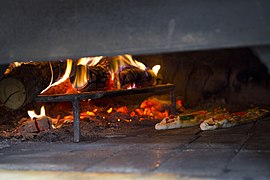Pita
Praèn
 Pita at the souq on Khaled ibn al-Waleed street, in the old city of Nablus, West Bank, Palestine. | |
| Jinis | Flatbread |
|---|---|
| Panggonan asal | Fertile Crescent, Middle East[1] |
| Woworan pokok | Flour, water, yeast, salt |
Pita ( /ˈpɪtə/ utawa US /ˈpiːtə/ ) [2] utawa Pitta ( Inggris Inggris ), iku salah siji suku yeast- ragi jinis flatbreads panggang saka glepung gandum, umum ing Mediterania, Tengah Wétan, lan tlatah liya tanggané. Iki kalebu versi sing kawr karo kanthong interior, uga dikenal minangka roti Arab (Arab: khubz ʿarabī ), roti Siria, lan jeneng liyane, uga versi tanpa kanthong kaya ta pita Yunani, sing digunakake kanggo mbungkus souvlaki .[3][4][5][6][7] ama ing donya kulon
rn jeneng pita kadhangkala bisa uga digunakake kanggo ngrujuk marang manéka jinis flatbreads sing duwe jeneng liya ing basa lokal sing, kaya ta akeh gaya khubz Arab (roti).[8]
Gladri
[besut | besut sumber]-
Pide baking ing oven kayu sing dipecat ing Istanbul
-
Karadeniz pidesi saka Turki paling ndhuwur karo keju kaşar
-
Pasang Ramadhan
-
Bungkus ombak Gyro
-
Panggang pita ing conveyor ing Tell Rifaat, Suriah
Referensi
[besut | besut sumber]- ↑ Marks, Gil (17 November 2010). Encyclopedia of Jewish Food. HMH. ISBN 9780544186316.
- ↑ "Pita". Cambridge English Pronouncing Dictionary (édhisi ka-18th). Cambridge University Press. 2011.
- ↑ Uvezian, Sonia (2001). Recipes and Remembrances from an Eastern Mediterranean Kitchen: A Culinary Journey Through Syria, Lebanon, and Jordan. Siamanto Press. kc. 313. ISBN 9780970971685 – lumantar Google Books.
The best-known bread of the region is khubz arabi (or, simply, khubz), a round, flat, slightly leavened loaf about one-fourth inch thick and with a pocket inside. It is made in three different sizes: large (eight or more inches in diameter), medium (six to eight inches), and small (about five inches). In America, where it has become very popular, this bread is known as pita. A pocketless version is also available. In some Arab communities khubz arabi is called kmaj (from the Persian kumaj), while in others, kmaj refers only to the pocketless type.
- ↑ Stewart, Jean E.; Tamaki, Junko Alice (1992). Composition of foods: baked products : raw, processed, prepared. Vol. 8. United States Department of Agriculture, Nutrition Monitoring Division. kc. 6. ISBN 9780160380440.
Pita bread originated in the Middle East and is also known as Arabic, Syrian, and pocket bread.
- ↑ Perry, Charles (21 August 2014). Davidson, Alan (èd.). The Oxford Companion to Food. Oxford University Press. kc. 629–630. ISBN 9780191040726 – lumantar Google Books.
- ↑ Wright, Clifford A. (2003). Little Foods of the Mediterranean: 500 Fabulous Recipes for Antipasti, Tapas, Hors D'Oeuvre, Meze, and More. kc. 61. ISBN 9781558322271.
- ↑ Roden, Claudia (24 December 2008). The New Book of Middle Eastern Food. Knopf Doubleday Publishing Group. kc. 393–396. ISBN 9780307558565 – lumantar Google Books.
- ↑ Serna-Saldivar, Sergio O. (2012). Cereal Grains: Laboratory Reference and Procedures Manual. kc. 215. ISBN 9781439855652.









